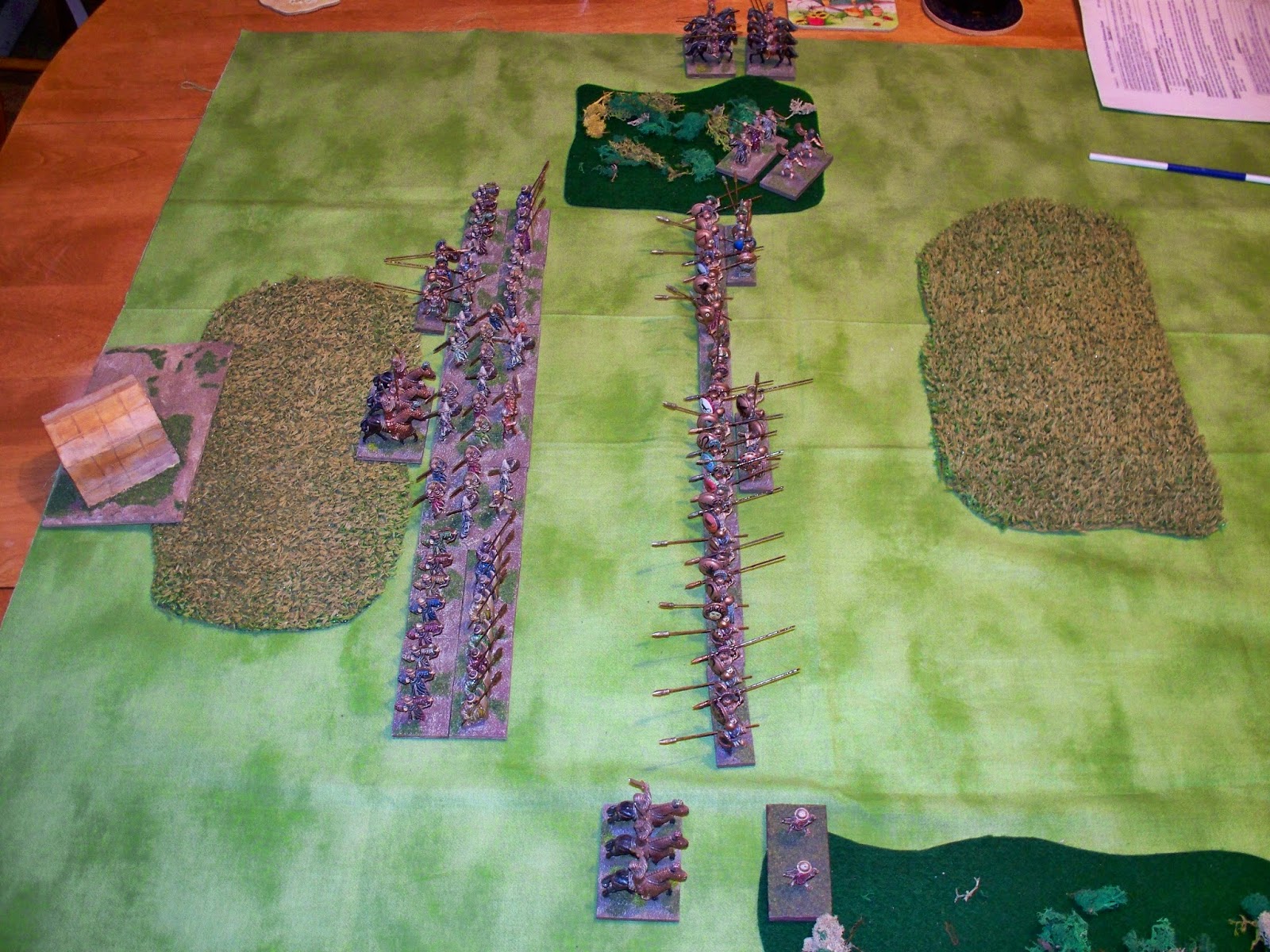The Persians fought a rematch with the Athenians. As in the first game, the Persians again were the defenders in spite of their higher aggression, and placed terrain accordingly. The Persians defend in Arable terrain, which means they must place either 1 Built Up Area or 2 plough as compulsory terrain pieces, and 2-3 other optional pieces. The Persians placed 2 plough and 2 scrub (rough going) pieces as shown. Neither side changed their allowed elements and used the same mix as before.
Above shows the starting deployment. The Persian main battle line on the left has Levy Horde in the center, flanked by Sparabara and Immortals. A cavalry element is on each wing, and the general and an allied hoplite element are in reserve. The Athenians deployed in a long line, with psiloi on each flank, and a reserve of hoplites and a cavalry element. The initial Persian pip die didn't effect the plough, so it remained good going.
Above shows the end of turn 1. The Athenian hoplite battle line advances. The Greek cavalry reserve moves towards the right, as Persian cavalry is heading that way, rounding the scrub on the flank. A Persian auxilia element has moved into that scrub. On the Greek left, another Persian cavalry element was approaching the scrub on that flank.
Above shows the end of turn 2. Low pips have slowed both sides, but the Athenian cavalry is now facing off against the Persian cavalry on their right flank as it comes round the scrub.
Above shows the end of turn 3. The Athenians have moved both psiloi and their sole cavalry element squarely into the threat zones of their Persian opponents, restricting their opponent's ability to move. The Persian elements in question only option is to either spend pips to move forward to attack, move straight back, or sit where they are. In the mean time, the Athenian hoplite battle line has resumed moving forward. Persian bows are now in range, but have had no effect in distant shooting (2 x 8Bw elements shooting with one support each vs. hoplites is a +2 for the bows vs +3 for the spears).
Above shows the end of turn 4. Low pips have again hampered both sides, but the Greek psiloi in the scrub on their left has recoiled the Persian cavalry element facing it. Persian bows still are having no effect in distant shooting.
Above shows the end of turn 5. Quite a lot has happened. In the scrub on their right, the Athenians moved a hoplite element to support the psiloi, recoiling the Persian auxilia there. In the center, the Athenian hoplite phalanx has crashed into the Persian main battle line. In the resulting melees, 2 Persian Levy Hordes and 1 Sparabara were destroyed. The third Persian Levy horde was beaten, but not doubled by the Athenians, so no result. The Sparabara elements on each flank were recoiled. Only the Immortals stood firm. The Persian right flank cavalry recoiled the Athenian psiloi in the scrub. The Athenians are winning 2-0 for killing the lone Sparabara (the first double element lost counts as two lost), the Levy Horde not counting as casualties against the Persians.
Above shows the end of turn 6. The Athenian hoplite center has destroyed a third Levy horde (not counting against the Persians) and an allied hoplite and the Immortals. The Athenians are now winning 3-0. The Athenian psiloi in the scrub at the top and bottom of the picture have both been recoiled or flee. The Persian center is gone and the way to the camp is open.
Above shows the end of turn 7. The Athenians destroy another Sparabara with a flanking hoplite on the Persian right. An Athenian Psiloi is lost attacking the Persian auxilia in the scrub at the top of the photo, even with support from an overlapping hoplite. The Athenians win the battle 4-1.
Discussion: The Persians were not able to delay the main hoplite battle line from closing for long, and their attempts to turn the Athenian flanks were too weak and were mostly countered. The terrain may have also hurt the Persians in this regard. The Persians will need to re-evaluate their choice of elements and terrain placement (though most was placed randomly).








No comments:
Post a Comment